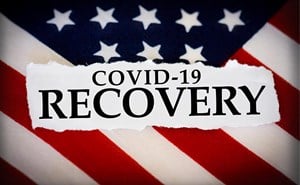As you well know, during the COVID-19 public health emergency (PHE), you, your emergency physician colleagues, and your group practices have not been immune from the economic consequences of reduced volume and income that hospitals and physicians of all types have been facing. Emergency Departments (EDs) across the country have experienced a significant reduction in volume since the pandemic began. Based on data from the Centers for Disease Control and Prevention (CDC), ED volumes dropped by around 40 percent in April compared to what they were in April of last year. Comparing 2020 to 2019 for the rest of the year, ED volumes started to pick back up, but the monthly averages were still down roughly 10 percent (if you are interested in seeing more ED-specific, real-time data, ACEP maintains a webpage that includes key statistics using data directly provided by the CDC).
I have written in previous Regs & Eggs posts about the various federal financial relief programs available to you and your group practices, but would like to take the opportunity to remind you about your options.
The most significant program that has been instituted to support healthcare providers during this difficult time is the Provider Relief Fund (PRF)—a fund created by Congress to cover providers’ lost revenues and increased expenses due to COVID-19. Over the last year, ACEP has written repeatedly to the U.S. Department of Health and Human Services (HHS) outlining issues with how the Department has chosen to allocate the funds as well as expressing concerns about the PRF’s confusing terms and conditions and reporting requirements.
Despite multiple rounds of distributions, there is still a significant amount of funding left in the PRF that HHS needs to allocate. According to the HHS webpage that tracks spending from this fund, providers have received approximately $105 billion out of the $178 billion in available funding. It is important to note that HHS only counts funds as distributed if providers have attested to the terms and conditions, so some of the remaining funds could still have been allocated and will be counted once providers submit their attestations. Nevertheless, even taking this into account, tens of billions of dollars are still available for distribution.
There are three important PRF updates from the last few months that you should know about.
- First, in mid-December, HHS announced that it had completed its review of applications for the third round of general distributions from the PRF. In this “Phase 3,” HHS stated that it would distribute $24.5 billion to over 70,000 providers—thereby covering close to 90 percent of each applicant’s reported lost revenues and net change in expenses caused by the coronavirus pandemic in the first half of 2020.
- Next, in late December, former President Trump signed into law the “Consolidated Appropriations Act, 2021” (the major COVID package), which among other provisions, included an additional $3 billion for the PRF (bringing the total amount in the fund to $178 billion). The Act also included other PRF stipulations: 1) a clarification that a parent organization can transfer provider relief funds to a subsidiary; 2) a description of how a provider may calculate lost revenues; and (3) an important requirement that HHS MUST pay out at least 85 percent of the remaining PRF funding (beyond the Phase 3 distribution) based lost revenues and increased expenses occurring in the third or fourth quarter of 2020 or the first quarter of 2021. HHS has not yet indicated how it plans on meeting this last requirement—but we expect that HHS soon will have to issue its plan for releasing the vast majority of the remaining PRF funds.
- Finally, last month, HHS released revised reporting requirements for individuals or groups that received over $10,000 from the PRF. Previously, the due date for submitting required information related to the use of funds was February 21, 2021. However, with these changes, HHS has extended the deadline, and will announce a new one in the coming weeks. In the meantime, HHS has opened up a reporting portal, and requests that all individuals or groups register. Registration takes around 20 minutes to complete. For more information, please visit the Provider Relief Fund website.
Besides the PRF, another important financial support option to explore (if you haven’t already) is the COVID-19 “Uninsured Program.” The program provides reimbursement at Medicare rates for COVID-19 treatment and testing and testing-related services delivered to patients who are uninsured. And if anyone would be well suited to take advantage of such a program, it is emergency physicians who see a higher proportion of uninsured patients than other specialists do!
Unfortunately, the program isn’t going as smoothly as we would like, as complicated and inappropriate program rules have led to numerous denials for what should be legitimate claims. While HHS had allocated $12 billion to the Uninsured Program, only $3.6 billion has actually been paid out to providers. This number is shockingly low, given that the Kaiser Family Foundation estimates that hospital costs alone for uninsured patients during the pandemic could be between $13.9 billion to $41.8 billion.
Last August, ACEP wrote a letter to HHS requesting fundamental changes to the Uninsured Program to address the underlying issues that are causing these denials (these issues are summarized in this Regs & Eggs blog post). However, HHS in its response stated that the parameters of the program are set by Congress and will not be changing. Even with the flaws, we still think that this program represents a good opportunity to get at least a portion of your uncompensated COVID-19 related care covered. You can start submitting your uninsured claims for reimbursement here.
The final program I would like to mention is the Paycheck Protection Program (PPP), which is administered by the Small Business Administration (SBA). The SBA is now allowing individuals and groups that have already received a PPP loan to apply for a “second draw.” To be eligible for a second draw (besides having to have already received a PPP loan), an applicant must have no more than 300 employees and be able to demonstrate at least a 25 percent reduction in gross receipts between comparable quarters in 2019 and 2020.
Unfortunately, we have heard some concerns about this last requirement. In general, medical practice revenues lag behind professional billing by 30 to 90 days, and sometimes more. Thus, most group practices saw their greatest drops in volume in April and May 2020 but did not realize their drops in revenue until June and July. This particular timing does not match up well with the calendar year quarter that the SBA currently requires applicants to use as a comparison point between 2020 and 2019 revenues. In some cases, revenues for your group practices dropped significantly during the second quarter of 2020 (April, May, and June) but not quite to 75 percent. However, revenues in a slightly different three-month period (for instance May, June, July) did drop below 75 percent. Thus, if you were able to report a quarterly revenue by any three contiguous months (and not by the calendar year quarter), you would qualify for the PPP second draw.
Given that some groups are being denied loans for this reason, ACEP recently reached out to the SBA to request some flexibility in allowing group practices to report losses in three contiguous months rather than a defined calendar year quarter. I will keep you updated on what we hear back from the SBA. In the meantime, you can find more details on the second draw, including a general overview and the pertinent SBA regulation, on the SBA’s website.
As the COVID-19 pandemic continues to rage on, we hope that you can continue to make use of these federal resources. Now, more than ever, it is essential that you and your groups have the financial security you need to keep EDs fully staffed and prepared to treat all patients that come through the door.
Until next week, this is Jeffrey saying, enjoy reading regs with your eggs.






